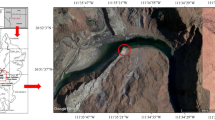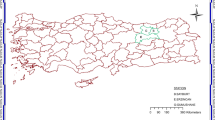Abstract
Deep-learning neural network (DNN) models are currently gaining popularity in the field of hydrology as well as flow forecasting. This is because these models have proven that they are capable of producing short-period forecasts with high accuracy. However, studies on flow forecasting for hydrological stations located upstream of river basins are still uncommon as the limited number of input parameters can be gathered in such places. This study looked into the capacity of DNN models to predict discharge upstream of the Da River in Vietnam, where the topography is mostly mountainous. Streamflow data from the LaiChau hydrological station — the largest and most distant hydrological station upstream of the Da River — has been gathered and employed as input for three DNN models. These models are the LSTM (long short-term memory neural network), ANN (artificial neural network), and CNN (convolutional neural network). According to research findings, the performance of the LSTM and CNN models outperforms that of the ANN, which has an NSE coefficient of just approximately 0.91. LSTM has a slight advantage over CNN, although the difference is modest because their NSE coefficients are 0.97 and 0.96, respectively. This finding suggests that DNN models, particularly LSTM, can be a feasible alternative for upstream hydrological station discharge predictions.











Similar content being viewed by others
Data availability
Data will be made available on request.
References
Abadi M, Agarwal A, Barham P, Brevdo E, Chen Z, Citro C et al (2015) TensorFlow: Large-scale machine learning on heterogeneous distributed systems. ArXiv abs/1603.04467
Adnan RM, Petroselli A, Heddam S, Santos CAG, Kisi O (2021) Short term rainfall-runoff modelling using several machine learning methods and a conceptual event-based model. Stoch Environ Res Risk Assess 35:597–616. https://doi.org/10.1007/s00477-020-01910-0
Amidi A, Amidi S (2018) Convolutional Neural Networks cheatsheet. https://stanford.edu/~shervine/teaching/cs-230/cheatsheet-convolutional-neural-networks. Accessed Oct 2022
Ardabili S, Mosavi A, Dehghani M, Várkonyi-Kóczy AR (2020) Deep Learning and Machine Learning in Hydrological Processes Climate Change and Earth Systems a Systematic Review. Cham, pp. 52–62. https://doi.org/10.1007/978-3-030-36841-8_5
Banerjee A, Chakrabarty M, Rakshit N, Bhowmick AR, Ray S (2019) Environmental factors as indicators of dissolved oxygen concentration and zooplankton abundance: Deep learning versus traditional regression approach. Ecol Indic 100:99–117. https://doi.org/10.1016/j.ecolind.2018.09.051
Belayneh A, Adamowski J, Khalil B, Quilty J (2016) Coupling machine learning methods with wavelet transforms and the bootstrap and boosting ensemble approaches for drought prediction. Atmos Res 172–173:37–47. https://doi.org/10.1016/j.atmosres.2015.12.017
Chollet F et al (2015) Keras. https://github.com/fchollet/keras. Accessed 6 June 2020
CRED (2020) Natural disasters 2019: Now is the time to not give up. Centre for Research on the Epidemiology of Disasters (CRED), Brussels
Đurin B, Plantak L, Bonacci O, Di Nunno F (2023) A Unique Approach to Hydrological Behavior along the Bednja River (Croatia) Watercourse. Water 15:589. https://doi.org/10.3390/w15030589
Freire PKdMM, Santos CAG, Silva GBLd (2019) Analysis of the use of discrete wavelet transforms coupled with ANN for short-term streamflow forecasting. Appl Soft Comput 80:494–505. https://doi.org/10.1016/j.asoc.2019.04.024
Goodfellow I, Bengio Y, Courville A (2016) Deep Learning. MIT Press
Govindaraju RS (2000) Artificial neural networks in hydrology. II: Hydrologic applications. J Hydrol Eng 5:124–137. https://doi.org/10.1061/(ASCE)1084-0699(2000)5:2(124)
Gupta HV, Kling H, Yilmaz KK, Martinez GF (2009) Decomposition of the mean squared error and NSE performance criteria: Implications for improving hydrological modelling. J Hydrol 377:80–91. https://doi.org/10.1016/j.jhydrol.2009.08.003
Hamitouche M, Molina J-L (2022) A Review of AI Methods for the Prediction of High-Flow Extremal Hydrology. Water Resour Manag 36:3859–3876. https://doi.org/10.1007/s11269-022-03240-y
Ho HV, Nguyen DH, Le X-H, Lee G (2022) Multi-step-ahead water level forecasting for operating sluice gates in Hai Duong. Vietnam Environ Monit Assess 194:442. https://doi.org/10.1007/s10661-022-10115-7
Hochreiter S, Schmidhuber J (1997) Long short-term memory. Neural Comput 9:1735–1780. https://doi.org/10.1162/neco.1997.9.8.1735
Hu H, Zhang J, Li T (2021) A Novel Hybrid Decompose-Ensemble Strategy with a VMD-BPNN Approach for Daily Streamflow Estimating. Water Resour Manag 35:5119–5138. https://doi.org/10.1007/s11269-021-02990-5
Hunter JD (2007) Matplotlib: A 2D graphics environment. Comput Sci Eng 9:90–95. https://doi.org/10.1109/MCSE.2007.55
Hussain D, Khan AA (2020) Machine learning techniques for monthly river flow forecasting of Hunza River, Pakistan. Earth Sci Inform 13:939–949. https://doi.org/10.1007/s12145-020-00450-z
Hussain D, Hussain T, Khan AA, Naqvi SAA, Jamil A (2020) A deep learning approach for hydrological time-series prediction: A case study of Gilgit river basin. Earth Sci Inform 13:915–927. https://doi.org/10.1007/s12145-020-00477-2
Khosravi K, Golkarian A, Tiefenbacher JP (2022) Using Optimized Deep Learning to Predict Daily Streamflow: A Comparison to Common Machine Learning Algorithms. Water Resour Manag 36:699–716. https://doi.org/10.1007/s11269-021-03051-7
Kingma DP, Ba J (2014) Adam: A method for stochastic optimization. ArXiv abs/1412.6980
Latt ZZ, Wittenberg H (2014) Improving flood forecasting in a developing country: A comparative study of stepwise multiple linear regression and artificial neural network. Water Resour Manag 28:2109–2128. https://doi.org/10.1007/s11269-014-0600-8
Le XH, Ho HV, Lee G (2019a) River streamflow prediction using a deep neural network: a case study on the Red River. Vietnam Korean J Agric Sci 46(843–856):1. https://doi.org/10.7744/kjoas.20190068
Le XH, Ho HV, Lee G, Jung S (2019b) Application of Long Short-Term Memory (LSTM) Neural Network for Flood Forecasting. Water 11:1387. https://doi.org/10.3390/w11071387
Le XH, Lee G, Jung K, An H-u, Lee S, Jung Y (2020b) Application of Convolutional Neural Network for Spatiotemporal Bias Correction of Daily Satellite-Based Precipitation. Remote Sens 12:2731. https://doi.org/10.3390/rs12172731
Le XH, Nguyen DH, Jung S, Yeon M, Lee G (2021) Comparison of Deep Learning Techniques for River Streamflow Forecasting. IEEE Access 9:71805–71820. https://doi.org/10.1109/ACCESS.2021.3077703
Le X-H, Ho HV, Lee G (2020a) Application of Gated Recurrent Unit (GRU) Network for Forecasting River Water Levels Affected by Tides. In Proceedings of APAC 2019, Singapore, pp. 673–680. https://doi.org/10.1007/978-981-15-0291-0_92
Le X-H, Nguyen Van L, Duc Hai N, Nguyen GV, Jung S, Lee G (2023a) Comparison of bias-corrected multisatellite precipitation products by deep learning framework. Int J Appl Earth Obs Geoinf 116:103177. https://doi.org/10.1016/j.jag.2022.103177
Le X-H, Van LN, Nguyen GV, Nguyen DH, Jung S, Lee G (2023b) Towards an efficient streamflow forecasting method for event-scales in Ca River basin, Vietnam. J Hydrol Reg Stud 46:101328. https://doi.org/10.1016/j.ejrh.2023.101328
Lee G, Nguyen DH, Le X-H (2023) A Novel Framework for Correcting Satellite-Based Precipitation Products for Watersheds with Discontinuous Observed Data, Case Study in Mekong River Basin. Remote Sens 15:630. https://doi.org/10.3390/rs15030630
Lehmann J, Coumou D, Frieler K (2015) Increased record-breaking precipitation events under global warming. Clim Change 132:501–515. https://doi.org/10.1007/s10584-015-1434-y
McKinney W (2010) Data structures for statistical computing in Python. In Proceedings of 9th Python in Science Conference, Austin, TX, USA, 28 June – 3 July, pp. 51–56
Nash JE, Sutcliffe JV (1970) River flow forecasting through conceptual models Part I - A discussion of principles. J Hydrol Eng 10:282–290. https://doi.org/10.1016/0022-1694(70)90255-6
Nguyen HD (2022) GIS-based hybrid machine learning for flood susceptibility prediction in the Nhat Le–Kien Giang watershed. Vietnam Earth Sci Inform 15:2369–2386. https://doi.org/10.1007/s12145-022-00825-4
Nguyen DH, Le XH, Anh DT, Kim S-H, Bae D-H (2022) Hourly streamflow forecasting using a Bayesian additive regression tree model hybridized with a genetic algorithm. J Hydrol 606:127445. https://doi.org/10.1016/j.jhydrol.2022.127445
Olah C (2015) Understanding LSTM networks. http://colah.github.io/posts/2015-08-Understanding-LSTMs/. Accessed 28 Nov 2020
Pedregosa F, Varoquaux G, Gramfort A, Michel V, Thirion B, Grisel O et al (2011) Scikit-learn: Machine Learning in Python. J Mach Learn Res 12:2825–2830
Phan T-T-H, Nguyen XH (2020) Combining statistical machine learning models with ARIMA for water level forecasting: The case of the Red river. Adv Water Resour 142:103656. https://doi.org/10.1016/j.advwatres.2020.103656
Rahimzad M, MoghaddamNia A, Zolfonoon H, Soltani J, DanandehMehr A, Kwon H-H (2021) Performance Comparison of an LSTM-based Deep Learning Model versus Conventional Machine Learning Algorithms for Streamflow Forecasting. Water Resour Manag 35:4167–4187. https://doi.org/10.1007/s11269-021-02937-w
Ronneberger O, Fischer P, Brox T (2015) U-Net: Convolutional Networks for Biomedical Image Segmentation. In Proceedings of Medical Image Computing and Computer-Assisted Intervention – MICCAI 2015, Munich, Germany, 5–9 October, pp. 234–241. https://doi.org/10.1007/978-3-319-24574-4_28
Rossum G (1995) Python tutorial. CWI (Centre for Mathematics and Computer Science), Amsterdam, The Netherlands
Shen C, Lawson K (2021) Applications of Deep Learning in Hydrology. Deep Learning for the Earth Sciences. pp 283–297
Simonyan K, Zisserman A (2014) Very Deep Convolutional Networks for Large-Scale Image Recognition. ArXiv abs/1409.1556
Sit M, Demiray BZ, Xiang Z, Ewing GJ, Sermet Y, Demir I (2020) A comprehensive review of deep learning applications in hydrology and water resources. Water Sci Technol 82:2635–2670. https://doi.org/10.2166/wst.2020.369
Tabari H (2020) Climate change impact on flood and extreme precipitation increases with water availability. Sci Rep 10:13768. https://doi.org/10.1038/s41598-020-70816-2
Tamiru H, Dinka MO (2021) Application of ANN and HEC-RAS model for flood inundation mapping in lower Baro Akobo River Basin, Ethiopia. J Hydrol Reg Stud 36:100855. https://doi.org/10.1016/j.ejrh.2021.100855
Thirumalaiah K, Deo MC (2000) Hydrological forecasting using neural networks. J Hydrol Eng 5:180–189. https://doi.org/10.1061/(ASCE)1084-0699(2000)5:2(180)
Van Der Walt S, Colbert SC, Varoquaux G (2011) The NumPy array: A structure for efficient numerical computation. Comput Sci Eng 13:22–30. https://doi.org/10.1109/mcse.2011.37
Xu T, Liang F (2021) Machine learning for hydrologic sciences: An introductory overview. WIREs Water 8:e1533. https://doi.org/10.1002/wat2.1533
Yadav B, Mathur S (2020) River discharge simulation using variable parameter McCarthy–Muskingum and wavelet-support vector machine methods. Neural Comput Appl 32:2457–2470. https://doi.org/10.1007/s00521-018-3745-1
Yadav B, Ch S, Mathur S, Adamowski J (2016) Discharge forecasting using an Online Sequential Extreme Learning Machine (OS-ELM) model: A case study in Neckar River, Germany. Measurement 92:433–445. https://doi.org/10.1016/j.measurement.2016.06.042
Yan L, Chen C, Hang T, Hu Y (2021) A stream prediction model based on attention-LSTM. Earth Sci Inform 14:723–733. https://doi.org/10.1007/s12145-021-00571-z
Yaseen ZM, Sulaiman SO, Deo RC, Chau K-W (2019) An enhanced extreme learning machine model for river flow forecasting: State-of-the-art, practical applications in water resource engineering area and future research direction. J Hydrol 569:387–408. https://doi.org/10.1016/j.jhydrol.2018.11.069
Zhao ZQ, Zheng P, Xu ST, Wu X (2019) Object Detection With Deep Learning: A Review. IEEE Trans Neural Netw Learn Syst 30:3212–3232. https://doi.org/10.1109/TNNLS.2018.2876865
Zounemat-Kermani M, Batelaan O, Fadaee M, Hinkelmann R (2021a) Ensemble machine learning paradigms in hydrology: A review. J Hydrol 598:126266. https://doi.org/10.1016/j.jhydrol.2021.126266
Zounemat-Kermani M, Mahdavi-Meymand A, Hinkelmann R (2021b) A comprehensive survey on conventional and modern neural networks: application to river flow forecasting. Earth Sci Inform 14:893–911. https://doi.org/10.1007/s12145-021-00599-1
Funding
This work was supported by the National Research Foundation of Korea (NRF) grant funded by the Korea government (MSIT)(No. 2020R1A2C1102758).
Author information
Authors and Affiliations
Contributions
All authors contributed to this study. Material preparation, data collection, and analysis were performed by Xuan-Hien Le, Duc Hai Nguyen, and Sungho Jung. The first draft of the manuscript was written by Xuan-Hien Le. The revised version was corrected by Giha Lee. All authors read and approved the final manuscript.
Corresponding authors
Ethics declarations
Competing interest
The authors declare no competing interests
Additional information
Communicated by: H. Babaie
Publisher's note
Springer Nature remains neutral with regard to jurisdictional claims in published maps and institutional affiliations.
Rights and permissions
Springer Nature or its licensor (e.g. a society or other partner) holds exclusive rights to this article under a publishing agreement with the author(s) or other rightsholder(s); author self-archiving of the accepted manuscript version of this article is solely governed by the terms of such publishing agreement and applicable law.
About this article
Cite this article
Le, XH., Nguyen, D.H., Jung, S. et al. Deep neural network-based discharge prediction for upstream hydrological stations: a comparative study. Earth Sci Inform 16, 3113–3124 (2023). https://doi.org/10.1007/s12145-023-01082-9
Received:
Accepted:
Published:
Issue Date:
DOI: https://doi.org/10.1007/s12145-023-01082-9




